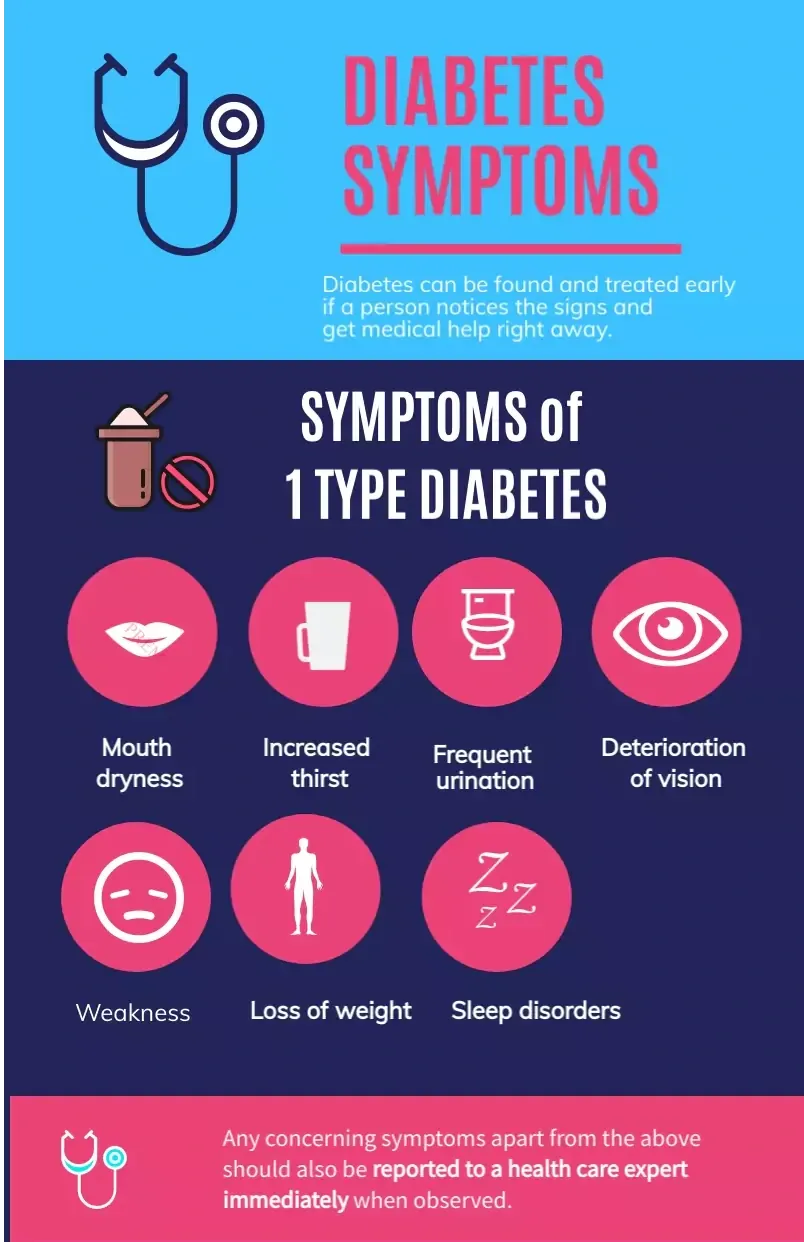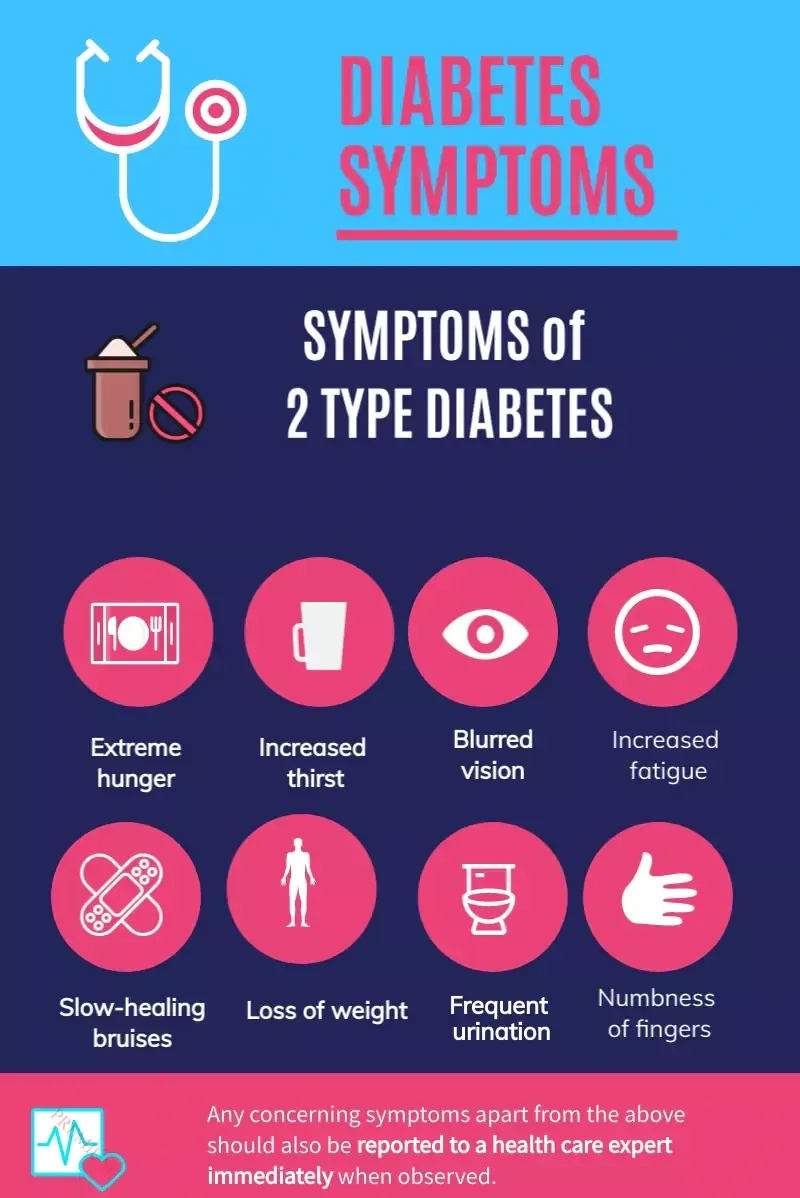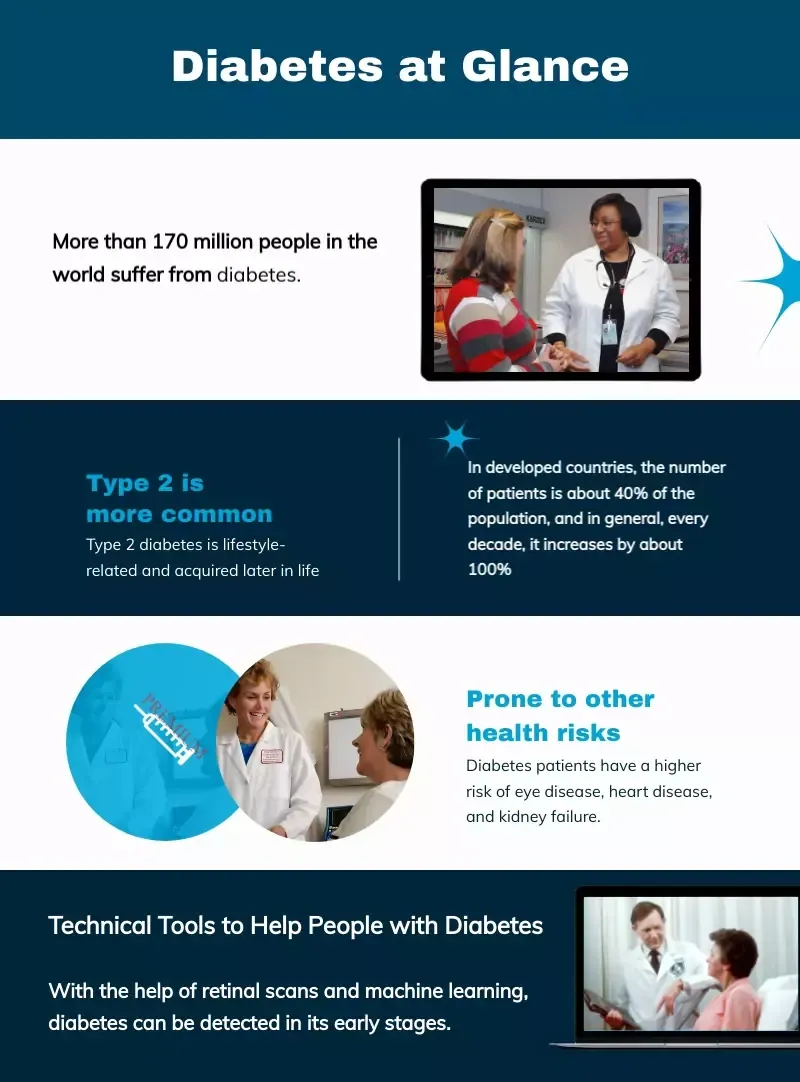Share
14 Mar. 2023
#health #diabetes #retina #scanning #eye
Overview of Diabetes Impacts on Eyesight

Different Types of Diabetes and Their Effect on Eye Health
One of the most widespread and pernicious diseases is diabetes mellitus. Today, more than 170 million people in the world suffer from it.
At the same time, in developed countries, the number of patients is about 40% of the population, and in general, every decade, it increases by about 100%. Diabetes has become a social disease because of how common it is and how often and badly it affects people. This has led the World Health Organization to raise the question of a non-infectious epidemic of this disease.
This article will talk about how diabetes can hurt the eyes, specifically through diabetic retinopathy, a disease that, if left untreated, can lead to sight loss permanently. We will also determine the possible risks of diabetic eye disease and ways to handle it. In addition, we will look at how technology, like scanning the retina, helps to find and treat diabetic eye disease.


Diabetes is a long-term metabolic disease in which the glucose level in the blood rises without being controlled. This is called hyperglycemia. Typically, the pancreas produces the hormone insulin, which regulates how cells take in glucose and how the body breaks down carbohydrates. Diabetes type I happens when insulin is not produced due to the autoimmune destruction of pancreatic beta cells.
In type 1 diabetes mellitus, which used to be called juvenile or insulin-dependent, insulin production stops because the body’s immune system destroys pancreatic beta cells. Environmental factors in genetically predisposed people are most likely to blame for this. This destruction doesn’t show up in the body for months or even years until the number of beta cells drops so much that there isn’t enough insulin to control high blood sugar.
Up until recently, type 1 diabetes was the most common type of diabetes diagnosed in people under the age of 30. It typically develops in childhood and adolescence. It is thought that the autoimmune destruction of beta cells is caused by the interaction of genes, autoantigens, and environmental factors (1).
The following are some examples of the primary initial symptoms:
- A feeling of mouth dryness
- Constant thirst
- Frequent urination
- Sleep disorders due to frequent urge to urinate
- General weakness, lethargy, rapid fatigue
- Loss of weight
- Deterioration of vision
Type 2 diabetes is characterized by resistance to insulin. Age and obesity are the two main risk factors for type 2 diabetes; in 60–90% of patients, these factors are significantly higher than average. But type 2 diabetes may also be inherited more easily than other types of diabetes. Numerous genes are involved in pancreatic beta-cell function. Their presence in the genome is associated with an increased risk of developing diabetes.
Type 2 diabetes symptoms usually come on slowly, so you might not even notice them. Some people have no symptoms.
Below are some of the symptoms of diabetes:
- Severe thirst or hunger
- Increased fatigue (feeling more tired than usual)
- More frequent urination
- Severe loss of weight
- Cuts or bruises that slowly heal
- Blurred vision
- Numbness or tingling in the palms or feet
In diabetes mellitus, complications such as:
Retinopathy - damage to the vessels of the eyes, leading not only to reduced vision but also to blindness
Nephropathy is accompanied by the development of chronic renal failure
Angina and myocardial infarction with damage to the heart vessels
Polyneuropathy
Injury and dementia

How Diabetes Affects Vision
The long-term effects of type 1 and type 2 diabetes are particularly dangerous to the visual system. People with diabetes who have high blood sugar levels may experience vision problems. These problems can be small annoyances or serious health problems like diabetic retinopathy, which can lead to blindness.
Specific abnormalities in the retina’s vessels and tissue are indicative of diabetic retinopathy. The retinal vessels' diameter and curvature change, along with microaneurysms, bleeding and swelling. When blood sugar levels are high, the body makes more insulin, which hurts and irritates the delicate cells in the retina. The result could be blurry vision or seeing flashes of light, which can wake a diabetic or keep them from getting a good night’s sleep. Glaucoma and cataract are also linked to diabetic retinopathy in addition to blindness.
Anyone with type 1 or type 2 diabetes should take steps to protect their eyesight and be aware of the risks the disease brings. Damage to the eyesight is one of the many problems that can come up with type 1 diabetes, which is a long-term illness. Problems with vision can range from mild irritations to things like diabetic retinopathy. Blurred vision is more common in those with type 1 diabetes. If not treated, this condition might cause irreversible sight loss.
.


Technical Tools to Help People with Diabetes
People with diabetes can keep an eye on and control their eye health with the help of mobile apps and other technological tools. Diabetic retinopathy can be detected early on with the help of retinal scans and machine learning. Managing diabetes and the associated vision issues is another area where image recognition is put to use in the form of customized suggestions. The use of these tools allows people with diabetes to keep tabs on their eye health and take preventative measures as early as possible.
Using retinal scanning technology, images of the retina can be analyzed to look for warning signs of retinopathy when it is still in its early stages (2). Its purpose is to aid patients with diabetes in taking care of their eyes by giving them individualized guidance on how to handle diabetes-related vision issues. Image recognition is used to put together personal risk factors and other warning signs that may show the start of diabetic retinopathy. Machine learning algorithms are used to make these devices so that they can better predict when eye problems or diseases will start to show up. Nowadays, those with diabetes may take better care of their eyes with the help of this technology.
Nowadays, there are great alternatives for people with diabetes in the form of the following mobile apps:
• iBGStar is a one-of-a-kind app that was developed specifically for people living with diabetes and the caregivers who assist them in better controlling the illness. The app tells users their blood sugar levels and daily goals based on the shape of their bodies. It also gives them ideas for food and exercise, sleep schedules, and reminders to check their blood sugar.
• Diabetic Buddy is a software that assists users with keeping track of their insulin dosages, glucose levels, food shopping lists, and medicine refills. Users can also keep an active health journal and share their progress quickly through social networks or blogs. It’s the ideal companion for anyone trying to keep their diabetes under control.
• MyFitnessPal is an app that can help people lose weight by covering all they need to know about eating, exercising, and tracking their weight. It does this by considering the user’s age and gender before coming up with personalized suggestions. It also has a lot of other useful features, like the ability to count calories and access a huge database of foods.
Those who have diabetes are now able to monitor their blood vessels for any anomalies that may suggest the beginning of eye issues by using a combination of technology called the Parsing Algorithm and mobile applications. People with diabetes can find out if something is wrong by measuring changes in the blood vessels over time. They might be able to better control their illness and protect their eyesight from further damage if they use different technological tools. Here’s a great example of how mobile apps are being used to give patients information that helps them deal with their illnesses better.
Gestational Diabetes & Its Effects on Eyesight
A separate point should be highlighted for gestational diabetes. Gestational diabetes is a condition that may affect women who are pregnant. Low vision ranks as one of the most frightening complications of gestational diabetes. Diabetes-related retinopathy does not make pregnancy harder or increase the risk to the baby’s health. But pregnancy, on the contrary, increases the risk of progression of retinopathy.
Blurred vision is one of the most common signs of gestational diabetes. The pathogenesis of retinopathy in gestational diabetes is similar between the two types of diabetes. Most people with this condition say that their vision is Recent increases in both diabetes and obesity during pregnancy show that pregnant women may be more likely to lose their eyesight in some way. Because of this, more people are likely to get serious eye problems like retinopathy and macular edema. This study shows how important it is for patients with gestational diabetes to keep a close eye on their blood sugar and take charge of their care.
The American Diabetes Association says that around week 10 of pregnancy, you should make an appointment for a glucose test that will take an hour. The American Congress of Obstetricians and Gynecologists recommends genetic testing for pregnant women who are at a high risk of getting gestational diabetes with complications because they are overweight or obese or have a history of diabetes in their family. All women should undergo testing before beginning prenatal care, according to the CDC’s recommendations. Scientists say that most pregnant women don’t know that they are at risk for gestational diabetes.
Pregnant women with a body mass index (BMI) of 25 or more and nonpregnant women with a BMI of 24.9–24.9 are encouraged to get evaluated for gestational diabetes. High blood sugar levels or abnormal glucose tolerance test results may prompt a recommendation for therapy; however, this is not always the case.
Up to 80% of people with diabetes get diabetic retinopathy, which causes hazy vision, night vision problems, and floaters. Depending on how bad the condition is, laser therapy, injections, or surgery may be used to treat it. Diabetics can protect their eyesight by learning about the signs and symptoms of diabetic retinopathy and the many ways to treat it that are possible with the technology that is available now.

Retinal Scanning as a Diabetes Treatment Option
The key to successful treatment of diabetes is an early diagnosis. People with diabetes may take charge of their health by learning about the warning signs, causes, and treatments for diabetic retinopathy. Retinal scanning is a process that takes detailed pictures of the retina using special equipment. By looking at these photos, doctors or computers can find problems in the blood vessels, such as leaks or blockages, that could be signs of diabetic retinopathy. Retinal scanning can also be used to find eye diseases like cataracts and glaucoma that are linked to diabetes. Early diagnosis of these disorders is critical for prompt treatment and vision loss prevention.
So, retinal scanning is a very important way to find out if someone has diabetic retinopathy or other eye problems caused by diabetes. By catching these problems early, doctors or apps can give the right treatment to stop or delay vision loss and help diabetic patients do better overall. It is a non-invasive process that uses machine-learning algorithms to look at the retinal images to find problems in the blood vessels. These algorithms can also be used to figure out how bad a disease is so that it can be treated sooner and better.
It is critical to keep current on the newest diabetes treatment technology and methods, as well as the possible hazards connected with diabetic eye illness. By investing in these tools and technologies, healthcare organizations may be able to improve the quality of care they give to diabetic patients, which could improve their health and make them happier.
Conclusion
Diabetes is a serious disease that can cause severe effects on eye health, such as damage to the eyes. Type 1 diabetes is relatively uncommon but affects around 400,000 individuals yearly. Type 2 diabetes is more common than type 1 diabetes due to a pancreas that isn’t working well or responding well to insulin.
To prevent these complications, people with diabetes should take steps to protect their eyesight and use technology such as retinal scans and machine learning to analyze images of the retina to look for warning or recognition signs. Recognition is also used to keep track of personal risk factors and other warning signs that could mean that diabetic retinopathy is starting.
Machine learning algorithms are used to better predict when a person’s eyes will start to have problems or get sick.
Aside from scanning the retina, other technological solutions can help people with diabetes. Patients can use glucose monitoring apps, for example, to measure their blood sugar levels in real-time and alter their medicine and lifestyle accordingly. Meal monitoring apps can help people with diabetes keep track of what they eat, which is an important part of caring for people with diabetes.
Also, people with diabetes can use apps like iBGStar, Diabetic Buddy, MyFitnessPal, and Glue Algorithm to help them get a better handle on their disease. These apps help users track their insulin dosages, glucose levels, food shopping lists, and medication refills, track their active health journal, and share their progress quickly through social networks or blogs. They also indicate how to keep an eye on their blood vessels for any changes that could indicate the start of vision problems.
2024 DBB Software. All rights reserved